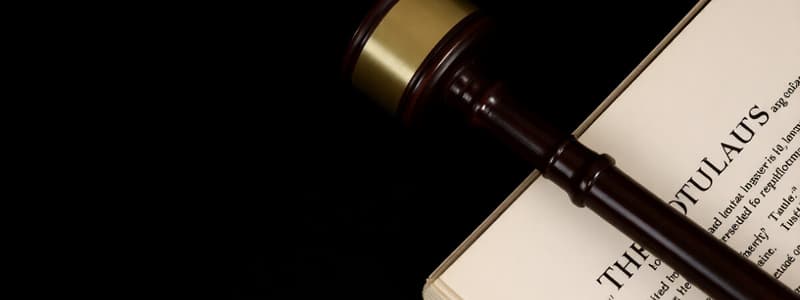Podcast
Questions and Answers
In a country operating under a common law system, what is the primary source of law?
In a country operating under a common law system, what is the primary source of law?
- Executive orders and administrative regulations.
- Scholarly interpretations of legal principles.
- Legislatively enacted statutes and codes.
- Judicial precedents and case law. (correct)
Which of the following scenarios best illustrates the application of tort law?
Which of the following scenarios best illustrates the application of tort law?
- Prosecuting an individual for theft.
- Seeking compensation for injuries caused by negligence. (correct)
- Enforcing the provisions of a written lease agreement.
- Negotiating the terms of a business merger.
How do governmental agencies primarily enforce codified laws?
How do governmental agencies primarily enforce codified laws?
- Through mechanisms like courts, police, and regulatory bodies. (correct)
- By depending on voluntary compliance from citizens.
- Through international treaties and agreements.
- By relying solely on public opinion and moral suasion.
Which area of law is primarily concerned with interpreting and applying the rules outlined in a country's constitution?
Which area of law is primarily concerned with interpreting and applying the rules outlined in a country's constitution?
What distinguishes civil law systems from common law systems?
What distinguishes civil law systems from common law systems?
A state legislature passes a law that contradicts a provision in the state's constitution. Which of the following principles determines the validity of the law?
A state legislature passes a law that contradicts a provision in the state's constitution. Which of the following principles determines the validity of the law?
In a common law system, a court is faced with a novel situation where no statute directly addresses the issue. What source of law will the court primarily rely on to make its decision?
In a common law system, a court is faced with a novel situation where no statute directly addresses the issue. What source of law will the court primarily rely on to make its decision?
A company believes that a regulation issued by a federal agency is overly burdensome and exceeds the agency's statutory authority. What branch of law would govern a challenge to this regulation?
A company believes that a regulation issued by a federal agency is overly burdensome and exceeds the agency's statutory authority. What branch of law would govern a challenge to this regulation?
Two parties are in a dispute over the terms of a contract. They agree to bring in a neutral third party to help them reach a mutually acceptable agreement, but this third party does not render a binding decision. Which form of alternative dispute resolution (ADR) are they using?
Two parties are in a dispute over the terms of a contract. They agree to bring in a neutral third party to help them reach a mutually acceptable agreement, but this third party does not render a binding decision. Which form of alternative dispute resolution (ADR) are they using?
A plaintiff is suing a defendant for negligence, alleging that the defendant's actions caused them harm. What must the plaintiff demonstrate to succeed in their claim, according to key legal concepts?
A plaintiff is suing a defendant for negligence, alleging that the defendant's actions caused them harm. What must the plaintiff demonstrate to succeed in their claim, according to key legal concepts?
In which legal system are comprehensive legal codes and statutes enacted by the legislature the primary sources of law?
In which legal system are comprehensive legal codes and statutes enacted by the legislature the primary sources of law?
If a court lacks the authority to hear a case, what legal concept is being violated?
If a court lacks the authority to hear a case, what legal concept is being violated?
Which of the following is an example of a primary authority in legal research?
Which of the following is an example of a primary authority in legal research?
What area of law governs agreements between parties creating rights and obligations enforceable in court?
What area of law governs agreements between parties creating rights and obligations enforceable in court?
A court decision in a particular state establishes a new interpretation of a law. How will this decision most likely affect future cases with similar facts in that state?
A court decision in a particular state establishes a new interpretation of a law. How will this decision most likely affect future cases with similar facts in that state?
Flashcards
What is Law?
What is Law?
A system of rules enforced by social or governmental institutions to regulate behavior.
Codified Law
Codified Law
Rules are written down and formalized.
Civil Law Systems
Civil Law Systems
Legal systems where laws are primarily derived from statutes and codes.
Common Law Systems
Common Law Systems
Signup and view all the flashcards
Contract Law
Contract Law
Signup and view all the flashcards
Primary Authorities
Primary Authorities
Signup and view all the flashcards
Statutes
Statutes
Signup and view all the flashcards
Case Law
Case Law
Signup and view all the flashcards
Regulations
Regulations
Signup and view all the flashcards
Common Law
Common Law
Signup and view all the flashcards
Civil Law
Civil Law
Signup and view all the flashcards
Constitutional Law
Constitutional Law
Signup and view all the flashcards
Criminal Law
Criminal Law
Signup and view all the flashcards
Property Law
Property Law
Signup and view all the flashcards
Litigation
Litigation
Signup and view all the flashcards
Study Notes
- System of rules are created and enforced through social or governmental institutions to regulate behavior.
- Complex and multifaceted subject with various branches and specializations.
- Rules are often codified and can be enforced through various mechanisms, including courts, police, and other governmental agencies.
- Legal systems vary between countries, with some having civil law systems and others have common law systems.
- Spans various sub-disciplines.
- Include constitutional law, criminal law, contract law, property law, and tort law.
Sources of Law
- Primary authorities: legally binding sources.
- Statutes are laws enacted by legislative bodies like Congress or Parliament.
- Case law consists of court decisions that interpret and apply statutes or establish legal principles.
- Regulations are rules promulgated by government agencies under authority granted by statutes.
- Constitutions establish the fundamental principles and framework of government, defining the rights and liberties of individuals.
- Secondary authorities: persuasive, but not binding.
- Legal treatises offer comprehensive analyses of legal topics.
- Law review articles provide scholarly commentary on current legal issues.
- Restatements of the Law summarize common law principles.
Legal Systems
- Different countries follow different legal system.
- Common Law: judge-made law, developed on a case-by-case basis.
- Emphasizes the role of precedent in judicial decisions.
- Found in countries like the United States, England, and Australia.
- A legal precedent is a principle or rule established in a prior court decision that is binding or persuasive for a court when deciding subsequent cases with similar issues or facts.
- Civil Law: codified statutes and legal codes are primary sources.
- Relies on comprehensive legal codes and statutes enacted by the legislature.
- Courts interpret and apply the law based on these codes.
- Used in countries like France, Germany, and Japan.
- Religious Law: based on religious doctrines or principles.
- Examples include Islamic law (Sharia) and Canon law.
- Governs various aspects of personal and religious life.
Branches of Law
- Constitutional Law: deals with the interpretation and application of constitutions.
- Defines the structure and powers of government.
- Protects fundamental rights and liberties of individuals.
- Criminal Law: involves offenses against society.
- Defines crimes and prescribes punishments for offenders.
- Prosecution is initiated by the government on behalf of the people.
- Contract Law: governs agreements between parties.
- Creates rights and obligations enforceable in court.
- Covers a wide range of transactions, such as sales, leases, and services.
- Property Law: concerns the rights and interests in real and personal property.
- Includes ownership, transfer, and use of property.
- Addresses issues such as zoning, land use, and environmental regulations.
- Tort Law: deals with civil wrongs causing harm to others.
- Provides remedies for injuries to person, property, or reputation.
- Includes negligence, intentional torts, and strict liability.
- Administrative Law: governs the actions and decisions of government agencies.
- Ensures accountability and transparency in administrative processes.
- Provides mechanisms for judicial review of agency actions.
- International Law: regulates relations between countries and international organizations.
- Includes treaties, customs, and general principles of law.
- Addresses issues such as trade, human rights, and armed conflict.
Legal process
- Litigation: process of resolving disputes in court.
- Begins with the filing of a complaint by the plaintiff against the defendant.
- Involves discovery, pre-trial motions, and trial.
- Ends with a judgment or settlement.
- Alternative Dispute resolution (ADR): methods of resolving disputes outside of court.
- Mediation involves a neutral third party who helps the parties reach a settlement.
- Arbitration involves a neutral third party who renders a binding decision.
- Negotiation involves direct communication between the parties to reach a mutually acceptable agreement.
Legal Professions
- Lawyers: licensed professionals who advise clients on legal matters and represent them in court.
- Duties include conducting legal research, drafting legal documents, and advocating for clients.
- Judges: preside over court proceedings and render decisions on matters of law and fact.
- Interpret laws, assess evidence, and oversee trials.
- Paralegals: assist lawyers with legal research, document preparation, and case management.
- Perform various tasks under the supervision of an attorney.
- Legal scholars: conduct research and analysis on legal issues.
- Publish articles, books, and treatises on legal topics.
- Teach law in academic institutions.
Key legal concepts
- Jurisdiction: Courts authority to hear and decide a case.
- Standing: A party's right to bring a lawsuit based on having suffered harm.
- Due process: Fair treatment through the normal judicial system.
- Equal protection: Ensures that laws are applied equally to all persons.
- Burden of proof: Obligation to prove one's assertion.
- Statute of limitations: Time limit for initiating a lawsuit.
- Res Judicata: Prevents re-litigation of issues already decided in court.
- Stare decisis: Following precedent in deciding cases.
Studying That Suits You
Use AI to generate personalized quizzes and flashcards to suit your learning preferences.




